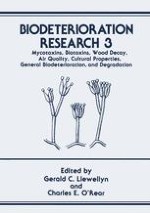1990 | OriginalPaper | Buchkapitel
Magnetic Resonance Investigation of Hemoglobin from Sickle Deteriorated Erythrocytes
verfasst von : Henry M. Zeidan
Erschienen in: Biodeterioration Research
Verlag: Springer US
Enthalten in: Professional Book Archive
Aktivieren Sie unsere intelligente Suche, um passende Fachinhalte oder Patente zu finden.
Wählen Sie Textabschnitte aus um mit Künstlicher Intelligenz passenden Patente zu finden. powered by
Markieren Sie Textabschnitte, um KI-gestützt weitere passende Inhalte zu finden. powered by
Sickle hemoglobin under physiological conditions and concentrations aggregates upon de oxygenation to form a viscous gel composed of long fibers consisting of filaments of stacked rings, of which several detailed structures have been proposed (Finch et al., 1973). The important change in sickle hemoglobin is substitution of a non-polar hydrophobic residue (valine) for a polar residue (glutamic acid). This suggests that hydrophobic interactions are important in stabilizing HbS aggregation (Votano et al., 1977). A variety of small molecules containing hydrophobic moieties have been shown to inhibit the aggregation or gelation of deoxygenated HbS (Novak et al. 1978, 1979). These agents include aryalalkanes (Ross and Subramanian, 1977), the aromatic amino acids (Noguchi and Schechter, 1977, 1978), aliphatic alchols, amides and ureas (Poillon, 1980), a variety of oligopeptides (Kubota and Yang, 1977; Votano et al., 1977; Gorecki et al., 1980), and a variety of phenyl derivatives (Gorecki et al., 1980; Poillon, 1982). The inhibitory effects of these agents are believed to be due to a competitive interference mechanism in which the inhibitor binds to the HbS molecule at one of the important contact sites, and blocks other HbS molecules from binding at that site (Abraham et al., 1975; Behe and Englander, 1979).
